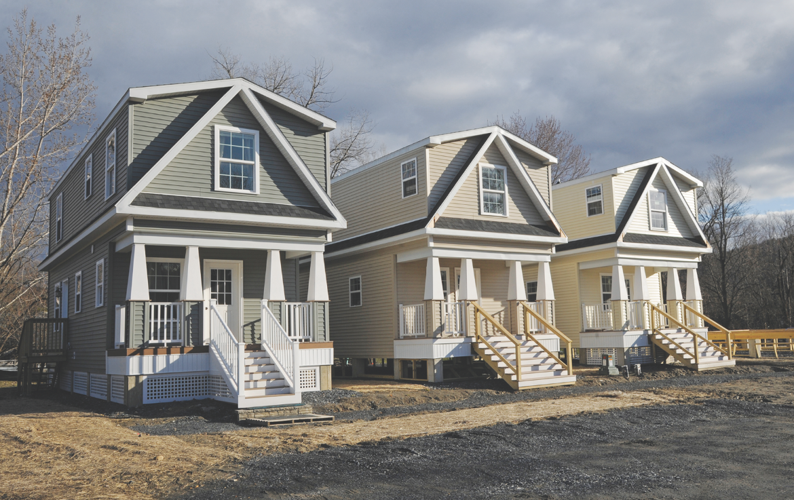A trend in energy-efficient homes has arrived in Waterbury — modular structures built in factories and wide-loaded hundreds of miles down the interstate.
The trend puts these cottage-style structures of one or two stories into pocket communities, designed as tightly knit developments with soft lighting, aggressive landscaping and meandering walking paths to engender neighborly bonhomie and trust.
“A pocket neighborhood is different from a traditional neighborhood because there’s a function: The front porch has to be big enough so you can sit on it on a Sunday morning as your neighbor walks by,” said Bob Provost of Carriage House Modular Homes LLC of South Burlington, between showings of the new Waterbury pocket community on rainy spring day.
The cottage homes are in the floodplain near Interstate 89’s Exit 10. It has already drawn attention from planners in Montpelier and at the Burlington Housing Trust, looking for 21st-century solutions to Vermont’s housing shortage.
Provost’s pocket community has sprouted in the ruins of the Whalley Trailer Park, which was destroyed by flooding in late August 2011 by Tropical Storm Irene. The new homes are engineered to withstand a 100-year storm — one so severe, there’s only a 1 percent chance it will occur in any given year. Lattices on the two-story cottages disguise the egret-like elevation of the foundations, more than a foot above the 100-year flood level. That plan brought a substantial drop in flood insurance rates, Provost said.
The cottages also come equipped with appliances and plumbing and are ready for cable and electricity and solar power, too, with a flat-screen TV over the mantel.
A few of the homes have been completely assembled, and the first sale closed in late April. The rest of the 11 cottages will soon be affixed to the foundations that line the driveway like a clear-cut forest.
The buyers paid the $199,000 introductory rate for a two-story cottage of 1,120 square feet appraised at $210,000.
It’s a house Santa might visit. The 2015 factory home with a 30-year mortgage is planted within walking distance of schools and the downtown, conveniently located near the roundabout connecting Routes 2 and 100 with the interstate.
“You want the parking away from where the people will be, so you’ve got kids playing out here in the green space and I know your kids and you know mine — kind of take care of each other,” Provost said. “The corner is fenced in from the highway, so it’s safe for kids and we’ll build a playground there.”
No citadel or gated community, the development aims to foster connectivity among residents in the pocket and outside. Sometime next spring, the effect will be completed with park benches, Adirondack chairs and lots of plantings and flowers: “That’ll be there for elderly people who want to watch the whole world go by,” Provost said.
Now that the stigma against manufactured housing is falling in some markets, as planners and developers seek greater efficiency, modular homes in pocket communities and on separate lots are beginning to sell.
“The perception that a lot of people have is that they’re still trailers,” Provost said. “This isn’t a trailer, but it’s built in a trailer factory, and what those trailer factories have is just a higher standard.”
Those higher standards often include replacing nails with screws, adding glue to joints, and using a bit more lumber than traditional housing.
Unlike trailer homes manufactured by these companies, the modular homes lack a steel chassis and sit atop a foundation — in this case, without a basement, because a basement could flood. Inside, the only part of the undecorated new cottage that feels like a vehicle might be described as that “new house smell.”
In the moderate-income housing market, buyers are telling Provost they can ditch the rental and get 30-year financing, as opposed to the typical 15-year note on a new trailer home without any land. What’s more, the electric should run only $50 to $60 per month, without solar.




(0) comments
Welcome to the discussion.
Log In
Keep it clean. Please avoid obscene, vulgar, lewd, racist or sexual language.
PLEASE TURN OFF YOUR CAPS LOCK.
Don't threaten. Threats of harming another person will not be tolerated.
Be truthful. Don't knowingly lie about anyone or anything.
Be nice. No racism, sexism or any sort of -ism that is degrading to another person.
Be proactive. Use the "Report" link on each comment to let us know of abusive posts.
Share with us. We'd love to hear eyewitness accounts, the history behind an article.